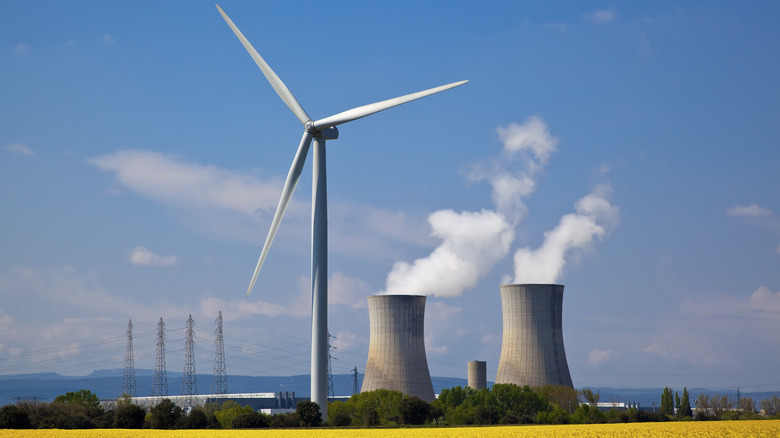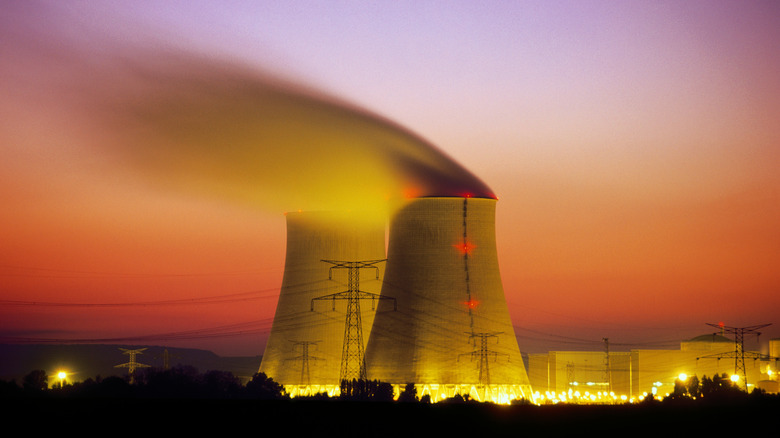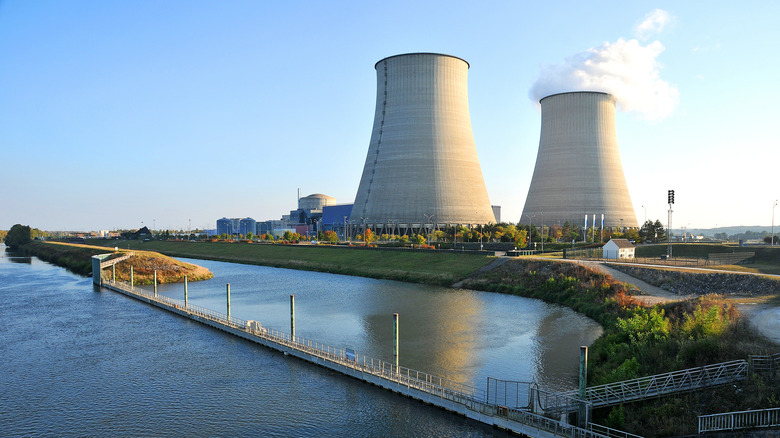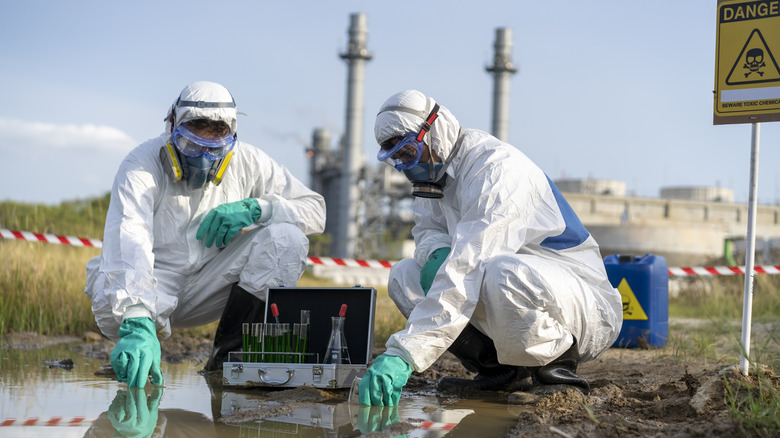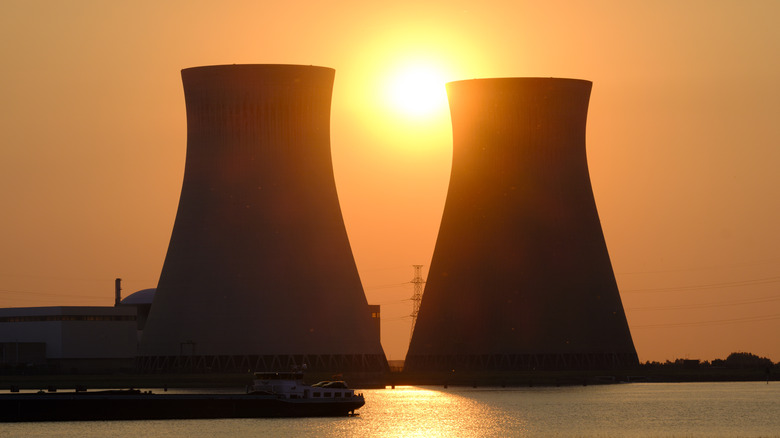Is Nuclear Energy Clean? Here's What You Need To Know
There's a lot of debate throughout the world about how to transition away from fossil fuels and replace them with clean, renewable forms of energy. The average person may tend to gravitate toward solar and wind alternatives, thinking those are the only forms of clean energy that exist. Most might be surprised to know that nuclear energy can be considered clean energy, and it's already widely used to power cities as well as keep military submarines running. When people hear the word "nuclear," they may immediately think of "Oppenheimer" or the Chernobyl meltdown. Weapons are only one application for nuclear energy, and nuclear power technology (and safety) has greatly improved since 1986.
No, nuclear power isn't a renewable source like wind or solar since it uses a finite resource to generate heat, but the amount of fuel required to create nuclear fission is only a fraction of the amount needed to create the same amount of power in a coal or gas power station. Sweden recently changed its stance on nuclear power, using it as a reliable supplement to help the transition phase until more renewable sources are running and reliable.
The International Energy Agency (IEA) in 2022 said, "Nuclear energy can help make the energy sector's journey away from unabated fossil fuels faster and more secure." It's likely that nuclear energy will help various countries reach their goal of reaching net zero carbon emissions by 2050.
Nuclear power plants don't emit toxins
Nuclear power plants rely on a little process called nuclear fission. Where "fusion" is combining two or more things together, "fission" is splitting them apart. Nuclear fission is specifically the process of splitting the atom of a heavy element like plutonium or uranium , resulting in a chain reaction of hundreds of thousands of little explosions. It all starts with one particle sent to collide an atom: That collision splits the atom into two smaller atoms, which in turn releases an immeasurable amount of neutrons. Those neutrons collide with other atoms and do it all over again repeatedly. Don't worry, those little explosions aren't happening out in the open or even in those large smokestacks at nuclear power plants.
The atoms, the chain reaction they create, and the heat it all generates are contained within what's known as a fuel rod. They're submerged underwater to create steam, which is subsequently pushed through a pipe that directs it to a turbine. The steam pushes the turbine to spin and create kinetic energy. The turbine then transfers its kinetic energy to a connected generator, which uses that to generate electricity.
A separate water source containing cold water circulates its water through pipes that run through a condenser under the turbine. This reverts the steam back into water and sends it back toward the fuel rods, where it will once again be heated and start the process all over again. Meanwhile, after absorbing the heat from the turbine, the water in the condenser pipe is transferred to a cooling tower and released into the atmosphere — the vapor you see leaving smokestacks.
There are major benefits to nuclear power
Nuclear energy can help cut down on carbon emissions since it produces nearly zero greenhouse gases. It was because of nuclear energy that the U.S. alone avoided generating more than 471 million tons of carbon dioxide in 2020. The Department of Energy compares it to "the equivalent of removing 100 million cars from the road and more than all other clean energy sources combined."
Yes, solar power and wind energy are arguably more ideal power generators because there's zero emissions and the necessary resources are almost always present. However, if it's a cloudy day, having solar panels on your roof won't do much good until the sun breaks through again. Nuclear energy, on the other hand, is going to generate power rain or shine. Thanks to modern technology, there are power plants that have an 80-year lifespan — 30 years longer than even a nuclear aircraft carrier. More importantly, that's a significantly longer shelf-life than most coal and gasoline power stations.
Nuclear power plants don't require as much real estate as some other clean power plants for the amount of power they can produce. The Nuclear Energy Institute (NEI) reports that a wind farm with the same capacity to produce power as a nuclear power plant would require "up to 360 times as much land area" in order to generate electricity at the same rate. A nuclear power plant on that scale — generating around 1,000 megawatts of power — only spans "just over one square mile." Furthermore, uranium pellets are incredibly dense, and take up no space at all when spent. All of the nuclear waste from the U.S. over the past 60 years could fit on a football field.
Nuclear power has a downside
Unfortunately, there is some truth to what the skeptics say, which is that nuclear power is harmful. Unless a power plant has a Chernobyl-level meltdown, they're perfectly safe while functioning. It's running out of a fuel source that's a problem. Disposing of spent fuel from a reactor is no easy task because it can't stay in the reactor, but it also can't be out in the open. Nuclear cores continue generating heat from radioactive decay, which is harmful to the environment and people. The U.S. Government Accountability Office (GAO) lists three types of nuclear waste: high-level, transuranic, and low-level waste, and each comes with different disposal requirements based on their toxicity levels.
High-level nuclear waste takes tens of thousands of years to decay, requiring storage in a permanent geological repository. The Department of Energy is responsible for disposing spent fuel, but "policymakers have been at an impasse over what to do with this spent fuel since 2010," according to GAO. A lack of permanent storage forces power plants across the country to store over 90,000 metric tons of spent fuel until further notice. The American government has paid billions of dollars in damages for failing to dispose of nuclear waste. That's not to say that there aren't some disposal sites around the U.S. at all.
There are low-level disposal sites in South Carolina, Washington, Utah, and Texas, as well as one in New Mexico for transuranic waste — a form of waste contaminated by material heavier than uranium, such as diluted plutonium.
The US could get more bang for its buck from nuclear power
Uranium pellets are incredibly dense, containing a considerable amount of potential energy within them. After only five years of constant use, uranium will have only expended a small portion of that potential energy. There are many countries in Europe and Asia that don't dispose of their fuel immediately after use, and instead recycle and reuse the expended fuel. Those countries will re-process used uranium to be recycled and placed into new fuel for reuse. The byproducts that aren't reusable are placed in glass containers and disposed of per usual. The U.S. doesn't currently practice recycling spent cores like other countries, believing that it's not economical enough to justify.
There are those who believe America might change its stance with the development of next-generation nuclear plants. As recently as 2022, U.S. Energy Secretary Jennifer Granholm said, "The Biden–Harris administration and DOE recognize the importance of developing practical uses for America's used nuclear fuel," according to Physics Today.
One notable name diving into the nuclear market is co-founder and former CEO of Microsoft, Bill Gates. He's chairman of TerraPower, an energy company in the middle of building a next-generation plant in the middle of Wyoming that will utilize a specialized coolant besides water. After leaving Microsoft in 2000, Gates focused on more philanthropic efforts, and it looks like nuclear energy is one such endeavor. Gates told PBS, "There's tremendous momentum building for new nuclear in the U.S. and the potential use of a far wider range of nuclear energy technology than we've seen in decades."
